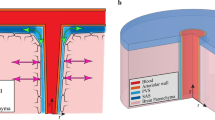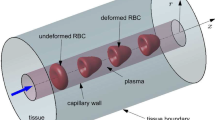Abstract
The fundamental question as to how erythrocyte transit time and flow path length ensure adequate oxygen extraction from blood during compromised blood supply or increased cerebral metabolic rate is still unanswered. A longer mean transit time would allow more complete deoxygenation of the arterial blood, however, it would attenuate the diffusion gradient of oxygen tension in the tissue. The importance of optimal erythrocyte flow path length for oxygen transport may be reflected in the characteristic tortuous pattern of cerebral capillaries (Wiederhold et al, 1976), which is different in various cytoarchitectural layers of the cerebral cortex (Duvernoy et al, 1981). Tortuosity may play a role in the prolongation of transit time to compensate for the high velocity of erythrocytes in cerebrocortical capillaries.
Access this chapter
Tax calculation will be finalised at checkout
Purchases are for personal use only
Preview
Unable to display preview. Download preview PDF.
Similar content being viewed by others
References
Duvernoy, H. M., Delon, S., and Vannson, J. L., 1981, Cortical blood vessels of the human brain, Brain Res. Bull., 7: 519.
Ferrari, M., Wilson, D. A., Hanley, D. F., and Traystman, R. J., 1989, Near infrared determined cerebral transit time and oxy- and deoxyhemoglobin relationships during hemorrhagic hypotension in the dog, Adv. Exp. Med. Biol., 248: 55.
Groebe, K., 1988, Coupling of hemodynamics to diffusional oxygen mass transport, Adv. Exp. Med. Biol., 222: 3.
Hasegawa, T., Ravens, J. R., and Toole, J. F., 1967, Precapillary arteriovenosus anastomoses. “Thoroughfare channel” in the brain. Arch. Neurol., 16: 217.
Hudetz, A. G., and Kiani, M. F., 1989, Hemodynamic optimization of computer generated capillary networks, Int. J. Microcirc., 8 (Suppl. 1): S16.
Hudetz, A. G., and Kiani, M. F., 1990, Dependence of cerebral capillary hematocrit on red cell flow separation at bifurcations: A computer simulation study. Adv. Exp. Med. Biol., 277: 31.
Hudetz, A. G., and Kiani, M. F., 1990, Dependence of cerebral capillary hematocrit on red cell flow separation at bifurcations: A computer simulation study. Adv. Exp. Med. Biol., 277: 31.
Hudetz, A.G., Spaulding, J.G. and Kiani, M.F., 1989, Computer simulation of cerebral microhemodynamics. Adv. Exp. Med. Biol., 248: 293.
Hudetz, A. G., and Werin, S., 1986, Percolation and transit in microvascular networks, Adv. Exp. Med. Biol., 200: 79.
Kiani, M. F., Cokelet, G. R., and Sarelius, I. H., 1991, Effect of diameter variability along the capillary segment on apparent pressure drop. Proc. Fifth World Congr. Microcirculat., Louisiville, KY, p. 50.
Kiani, M. F., and Hudetz, A. G., 1991, Mathematical model of apparent blood viscosity as a function of vessel diameter and discharge hematocrit. Biorheology. 28: 65.
Klitzman, B., and Johnson, P. C., 1982, Capillary network geometry and red cell distribution in hamster cremaster muscle. Am. J. Physiol., 242: H211.
Kobari, M., Gotoh, F., Fukuuchi, Y., Tanaka, K., Suzuki, N., and Uematsu, D., 1984, Blood flow velocity in the pial arteries of cats, with particular reference to the vessel diameter. J. Cereb. Blood Flow Metabol., 4: 110.
Little, J. R., Cook, A., Cook, S. A., and MacIntyre, W. J., 1981, Microcirculatory obstruction in focal cerebral ischemia: albumin and erythrocyte transit, Stroke: 12: 218.
Lübbers, D. W., and Leniger-Follert, E., 1978, Capillary flow in the brain cortex during changes in oxygen supply and state of activation, In: “Ciba. Fnd. Symp.” 56: 21.
Mayrovitz, H. N., and Roy, J., 1983, Microvascular blood flow: evidence indicating a cubic dependence on arteriolar diameter, Am. J. Physiol., 245: H1031.
Murray, C. D., 1926, The physiological principle of minimum work. I. The vascular system and the cost of blood volume, Proc. Natl. Acad. Sci. U.S.A., 12: 207.
Tomita, M., Gotoh, F., Amano, T., Tanahashi, N., Kobari, M., Shinohara, T., and Mihara, B., 1983, Transfer function through regional cerebral cortex evaluated by photoelectric method. Am. J. Physiol., 245: H385.
Wiederhold, K.-H., Bielser, W., Schultz, U., Jr., Veteau, M.-J., and Hunziker, O., 1976, Three dimensional reconstruction of brain capillaries from frozen serial sections, Microvasc. Res., 11: 175.
Yamakawa, T., Yamaguchi, S., Niimi, H., and Sugiyama, I., 1987, White blood cell plugging and blood flow maldistribution in the capillary network of cat cerebral cortex in acute hemorrhagic hypotension: An intravital microscopic study. Circulat. Shock. 22: 323.
Author information
Authors and Affiliations
Editor information
Editors and Affiliations
Rights and permissions
Copyright information
© 1992 Springer Science+Business Media New York
About this chapter
Cite this chapter
Hudetz, A.G. (1992). Computer Simulation of Erythrocyte Transit in the Cerebrocortical Capillary Network. In: Erdmann, W., Bruley, D.F. (eds) Oxygen Transport to Tissue XIV. Advances in Experimental Medicine and Biology, vol 317. Springer, Boston, MA. https://doi.org/10.1007/978-1-4615-3428-0_79
Download citation
DOI: https://doi.org/10.1007/978-1-4615-3428-0_79
Publisher Name: Springer, Boston, MA
Print ISBN: 978-1-4613-6516-7
Online ISBN: 978-1-4615-3428-0
eBook Packages: Springer Book Archive




